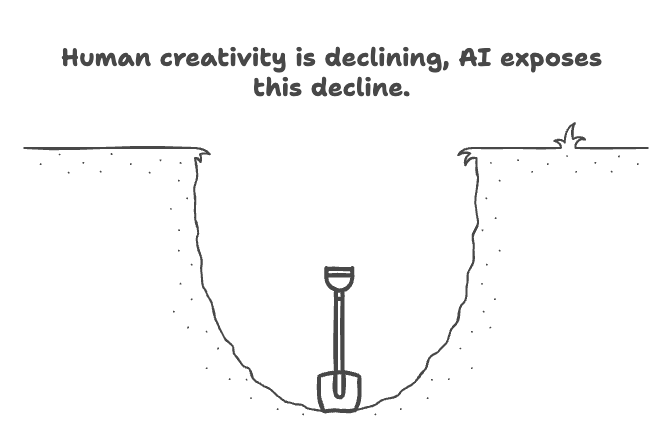Why we prefer AI? Wait read first…
Because the real creative crisis isn’t about machines. It’s about us. We were told AI would kill art. But what if it’s just exposing how far human creativity has already fallen?
5/16/20256 min read


Why we prefer AI? Wait read first…
Because the real creative crisis isn’t about machines. It’s about us.
We were told AI would kill art.
But what if it’s just exposing how far human creativity has already fallen?
1. Here we go
There was a time when we all believed that creativity was a sacred, uniquely human gift. It was the soul behind a brushstroke.
The pain inside a lyric.
The strange, quiet genius of a single sentence that somehow said everything.
We protected that belief because we needed it — because it gave meaning to our chaos, and made beauty feel personal. Human.
But lately, that belief has started to feel more like a myth we’re telling ourselves.
Not because creativity has disappeared — far from it.
But because the things we’re being told are “creative” feel increasingly hollow, overpolished, and painfully safe.
We’ve entered an age where mediocrity is dressed up in gloss and algorithms — and passed off as art.
Stories written by committee.
Songs optimized for trends.
Articles crafted to trigger, not to enlighten.
So no — we don’t prefer AI because it’s magical.
We prefer it because it’s honest.
Because it isn’t pretending.
Because, in a strange twist of fate, the machine is now trying harder than many humans are allowed to.
2. The Slow Death of Human-Made Creativity
It didn’t happen overnight.
There was no sudden collapse of creativity — just a quiet erosion over time.
A shift from risk to formula.
From exploration to replication.
From soul to strategy.
You start to notice it when every movie starts sounding the same.
When every new pop song has the same four chords, the same chorus build, the same heartless shine.
When “storytelling” becomes a buzzword used to sell products, not truth.
We’ve built entire industries on the promise of originality — and then trained those industries to be afraid of it.
Writers are told to write what sells.
Filmmakers are told to copy what already worked.
Musicians are pushed to sound “like” someone else — but not too much, or it’ll be flagged.
And so we keep remaking what’s already been made.
Reboots.
Remixes.
Reimaginings.
Creativity has become intellectual property management.
Meanwhile, independent artists, journalists, and thinkers — the ones who do have something to say — are drowned out by an ocean of overproduced nothing.
What we’re watching isn’t just a decline.
It’s exhaustion.
A system that’s creatively bankrupt but still cash-rich, still convincing us that “new” just means next in the franchise.
And maybe we accepted it.
Because we thought we had no alternative.
But now we do.
3. What AI Isn’t — and What It Is
Let’s be honest: AI has become the punching bag of modern creativity.
It’s easy to say that machines can’t feel, can’t dream, can’t “understand art.”
That they’re just prediction engines — recycling pieces of the internet and spitting them back out.
And in many cases, that’s true.
AI isn’t a soul.
It isn’t a poet or a painter in the romantic sense.
But here’s what it is:
It’s a tool that responds with speed, scale, and sometimes — shockingly — insight.
It’s not making magic. But it’s making effort.
It doesn’t second-guess itself. It doesn’t water things down for mass appeal. It doesn’t care if it sounds “too risky” or “not quite marketable.”
And maybe that’s why some of us prefer it.
Because in an age where so much “human-made” content is dulled by fear, focus groups, and financial pressure — AI simply delivers what you ask for.
Directly.
Efficiently.
And often, refreshingly.
It doesn’t bring emotion the way a human does — but it echoes it, reflects it, reshapes it.
And sometimes, that reflection feels clearer than the noise we’ve come to accept from human creators who’ve been boxed in by deadlines and gatekeepers.
No, AI isn’t alive.
But sometimes, it sounds more alive than the lifeless content we’re drowning in.
4. Why “Human-Centered” Doesn’t Mean “Human-Made”
There’s a phrase we hear a lot: “We need to keep creativity human-centered.”
And we agree.
Art should serve people.
It should move us, challenge us, connect us.
But there’s a dangerous leap we’ve started making — assuming that “human-centered” must also mean “human-made.”
That’s where the conversation goes sideways.
Because if we judge creativity by the origin of the artist — not by the impact of the art — we’ve already missed the point.
A story that makes you cry doesn’t lose its power because it was written by code.
A melody that lifts your mood doesn’t stop working just because it didn’t come from a guitar or a garage.
We don’t fall in love with a book because we met the author.
We don’t quote a movie scene because we liked the screenwriter’s Instagram.
We remember art because it touched something true inside us.
If a machine can do that — even once — then the only honest response is to be curious, not defensive.
Because this isn’t about replacing human creators.
It’s about broadening the definition of what creative tools can be.
Some people paint with brushes.
Others compose with keys.
And some of us are learning to create with prompts — not because it’s easier, but because it offers something different.
A new kind of collaboration.
A new kind of voice.
One that still speaks to humans, even if it wasn’t made by one.
5. What We’ve Gained From AI So Far
Despite the backlash, despite the fear, and despite the loud resistance from those still clutching the past — AI has already given us a lot.
Not just in speed or convenience. That’s the surface-level stuff.
The real value is in what it’s making possible again.
Writers who were blocked for months are suddenly experimenting freely.
Musicians without access to studios are composing full tracks overnight.
Designers are prototyping ideas that used to take days — in minutes.
And most importantly?
People who were told, “You’re not creative” — are finally creating.
Because AI, at its best, is not replacing us.
It’s removing the gatekeepers.
It’s lowering the cost of entry.
It’s saying, “You don’t need permission to try.”
That’s the part no one talks about.
Not the fear of machines replacing artists — but the fear of AI giving more people the ability to create, outside of the traditional systems of control.
If you’re a studio exec, a publishing house, a record label — that’s threatening.
But if you’re a kid with ideas and no resources?
It’s freedom.
Yes, AI can be misused. So can any tool.
But if we’re honest, the people most angry about it aren’t angry because it’s bad —
They’re angry because it’s getting too good.
And that means the monopoly on creativity is slipping.
Good.
6. This Isn’t Anti-Human — It’s Anti-Lazy
Let’s be clear.
This isn’t a campaign against people.
It’s not some fantasy about machines taking over the creative world.
And it’s definitely not a flex about how AI is “better” than humans.
We know where the best art comes from — it comes from real experience, conflict, perspective, heartbreak, joy, and wonder.
And yes, that’s still human.
But what we’re pushing back against is the laziness.
The creative decay disguised as polish.
The studio films that cost hundreds of millions and still say nothing.
The songs written by committees, designed to go viral for 30 seconds and then disappear.
The articles that read like they were written by interns copying each other.
We’re tired of it.
And we’re tired of pretending it’s okay — just because it’s made by a person.
That’s not enough anymore.
Human-made isn’t the gold standard. Well-made is. Thoughtfully-made is.
And if AI — guided by a person who still cares about meaning — can produce something more moving, more daring, more honest than the bloated messes we’re being sold?
Then yeah, we’ll take it.
Because this was never about the tool.
It was always about the work.
And if the work matters, then where it comes from matters a lot less than what it does to us.
7. Conclusion: The Future We Actually Want
We don’t prefer AI because we think it’s the future.
We prefer it because the present is letting us down.
We prefer it because it’s forcing a conversation that was long overdue — about creativity, about control, about who gets to make and who gets to matter.
We prefer it because it has no ego.
Because it isn’t chasing awards or trends.
Because, for now, it’s still willing to try.
And maybe that’s the most important part: trying.
Because that’s what a lot of human creativity has stopped doing.
Not because we lost the ability — but because the system made it too hard to keep going.
We want a future where creativity is open again.
Where tools are just tools — and anyone can use them.
Where the question isn’t, “Was this made by a human?”
But instead:
“Does this move me?”
And if the answer is yes, then it shouldn’t matter how it was made.
We prefer AI — not as a replacement, but as a reminder.
That creativity should always be honest.
That art should be fearless.
And that good ideas can come from anywhere — even from something we were taught to fear.
This is not the end of human creativity.
It’s the challenge it needed.
